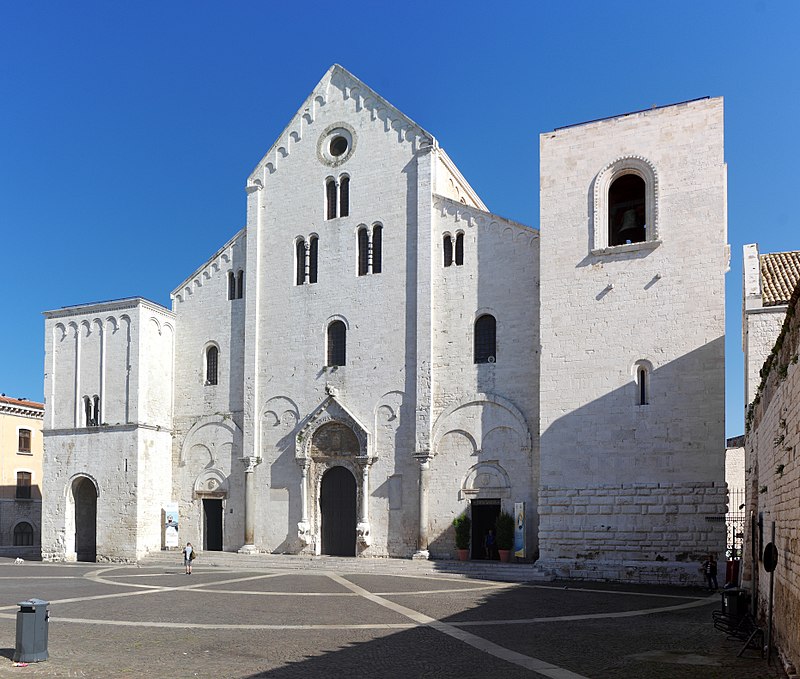
Bari, basilica of San Nicola (photo by Berthold Werner, CC BY-SA 3.0, https://commons.wikimedia.org/w/index.php?curid=61405024)
The basilica of San Nicola, commissioned by the Benedictine abbot Elia in 1089, was consecrated in 1197. The cultured abbot wanted to build a building that in itself summarized numerous functions and different meanings. It was to be a pilgrimage church, the mother church of the people of the Bari area and a point of reference for those who came from the sea and immediately confronted the towering silhouette of its towers.
Entering the urban fabric, after skirting the castle and the cathedral, walking along Via delle Crociate, crossing the Angevin arch, you reach the square of San Nicola.
The basilica, which is an expression par excellence of Apulian Romanesque architecture, imposes itself majestically with its severe and candid tripartite facade, enlivened only by blind arches that chase each other up to the tympanum of the main portal and, on the upper register, the slight chiaroscuro play of single and double lancet windows.
The solid volumes of the building are fully perceptible thanks to the deep arches that run on the side perimeter of the building.
The upper register is lightened on the sides by the elegant flow of six-light windows which, like stone embroidery, allow the light to create intriguing plastic effects.
It is a perfectly unitary structure with a fortress-like appearance that refers to the large Romanesque cathedrals of the North in the layout of the façade flanked by two mighty towers, but which does not renounce to enclose the volumes of domes and vaults within rectilinear structures, in harmony with the techniques Middle Eastern construction and in homage to the long Apulian construction tradition. To allow the influx of pilgrims, who flocked to visit the relics of San Nicola, along the perimeter of the basilica there are five portals decorated with sculptures that successfully combine the beauty of the forms with the didactic richness of the contents. All the energy of the Apulian Romanesque style explodes in the sculptural decorative apparatus of San Nicola: populated worlds of monstra, drawn directly from the Nordic bestiaries, coexist with precise classic citations, enriched by motifs of clear Islamic origin, taken from fabrics and precious objects that arrived on the Apulian coasts with pilgrims and merchants.
You can also spot the portal known as the lions, which opens on the left side of the basilica, just below the first of the side arches. Along the archivolt, the story of the Normans, new lords of Bari, is told through sculpture. With a ductus of extraordinary narrative and propagandistic happiness, the refined textures of the Bayeux tapestry seem to take on new life and new forms in these sculptures landed in the city to tell the stories of the lords of the North to the new southern subjects.
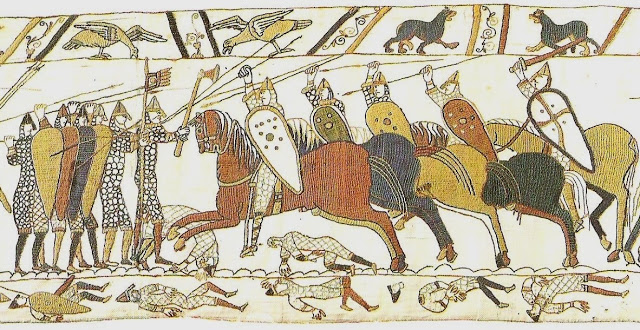
Arazzo di Bayeux, 11th century, today exhibited in the Center Guillaume-le-Conquérant in Bayeux, detail.
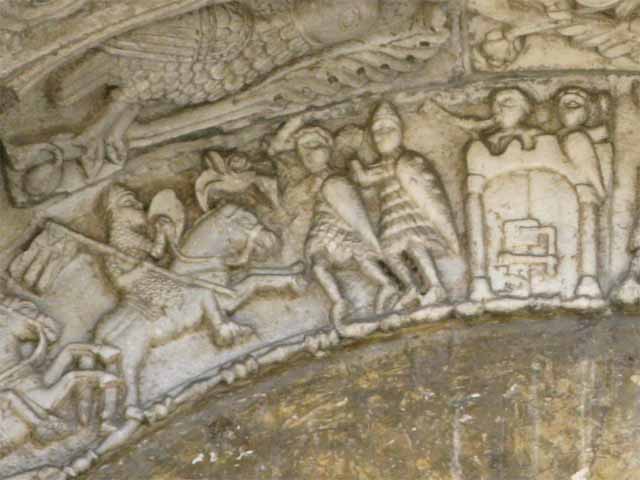
Bari, Basilica of San Nicola, porta dei leoni, 12th century, detail.
The sculptures of the two oxen stylofori that adorn the prothyrum of the central portal of the basilica are decidedly more Mediterranean in flavor, the work of an anonymous sculptor are able to combine motifs of the local classical tradition with a language that is already fully novel and European.
For centuries, the elders of old Bari have narrated a legend to travelers who stopped in front of the church. When the body of the Saint of Myra reached the city:
i cittadini non erano d’accordo sul luogo dove riporlo. Perciò fu stabilito di prendere dei buoi dalla campagna e di deporre le reliquie in una chiesa da costruirsi lì dove gli animali avessero trasportato il carro. Allora i buoi trassero il carro sul quale era stato posato il santo corpo dalla riva del mare. E la chiesa di San Nicola fu costruita lì, nel mare, donde l’acqua penetra talvolta nella cripta. (A. Adorno, Itinéraire d’Anselme Adorno en Terre Sainte)
Indeed, the position of the Nicolaian basilica, despite the legend, is by no means casual, but responds to precise symbolic and political needs. The new Palatine church was to rise where the Catapano palace stood, to indicate that now the patron saint, and with him the Norman lords who had sponsored the construction of the church, were to occupy the place and role that once belonged to the Byzantines; moreover, its position close to the sea had to emphasize the close relationship of the city with the Adriatic Sea. For this reason, the apse area of the basilica, oriented towards the sea, is treated as if it were a second facade, with a large window decorated with carved animals. These are elephants and sphinxes, which in addition to their symbolic meanings allude to that East towards which pilgrims and merchants headed or returned, after embarking in Bari under the protection of San Nicola.
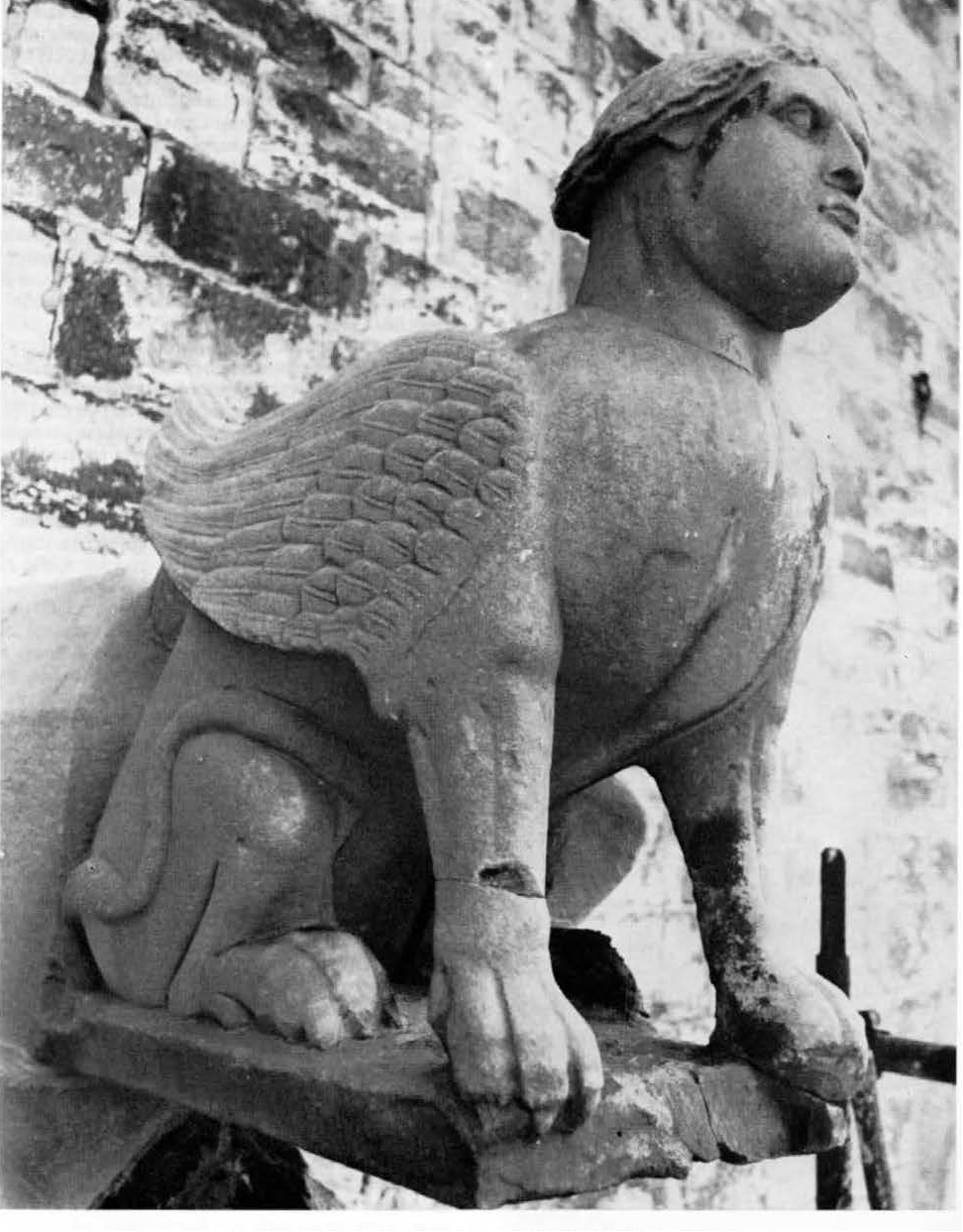
Bari, Basilica of San Nicola, Sphinx carved on the apse window, detail.
The interior of the church has a Latin cross plan with the arms of the transept contracted; it is divided into three naves by huge oriental imported columns, adorned with carved capitals that alternate with pillars. The transverse arches follow the first building phase.
In the presbyteral area, travelers will be able to admire the so-called chair of Abbot Elia. The seat, which was intended for the high prelate, is entirely carved in marble by an artist who was able to combine the Byzantine refinement in the treatment of the decorative parts, with the Romanesque expressionism of the telamons holding the chair and depicted with the deformed face by the effort and weight of sin.
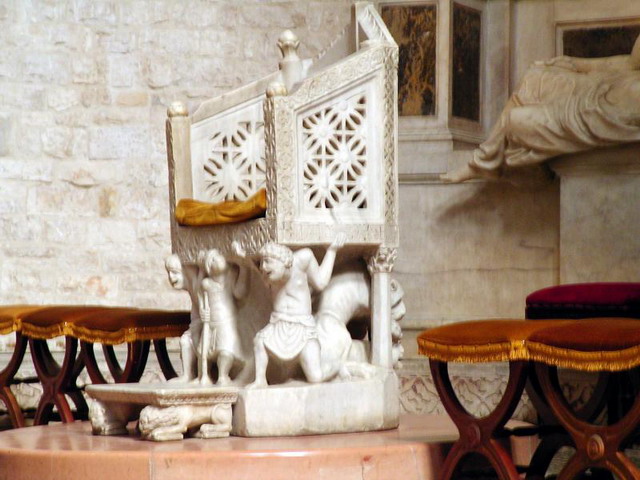
Bari, basilica di San Nicola, interno, cattedra dell’abate Elia
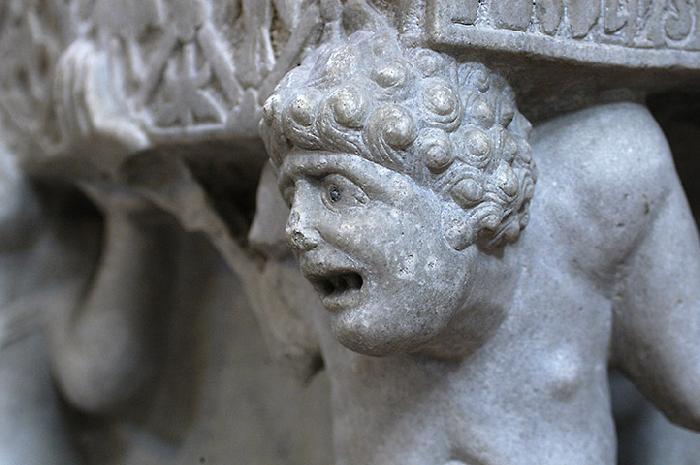
Bari, basilica di San Nicola, interno, cattedra dell’abate Elia, particolare.
In questa solenne cornice romanica si confrontano, in un suggestivo contrasto, la raffinata art de cour trapiantata dall’Ile de France dagli angioini, che succedettero ai Normanni e agli Svevi alla guida della città, e il fasto orientale, dal sapore tutto bizantino, della cripta gremita di arredi sontuosi ed icone. (M. S. Calò Mariani, L’immagine ed il culto di san Nicola a Bari e in Puglia)
Si accede alla cripta tramite una scalinata posta sulla navata laterale che conduce il fedele in una dimensione mistica, grazie alla profusione di icone, lampade, arredi in metalli preziosi, tessuti e ricami che concorrono a rendere estremamente suggestiva la vista delle reliquie di San Nicola, qui conservate.
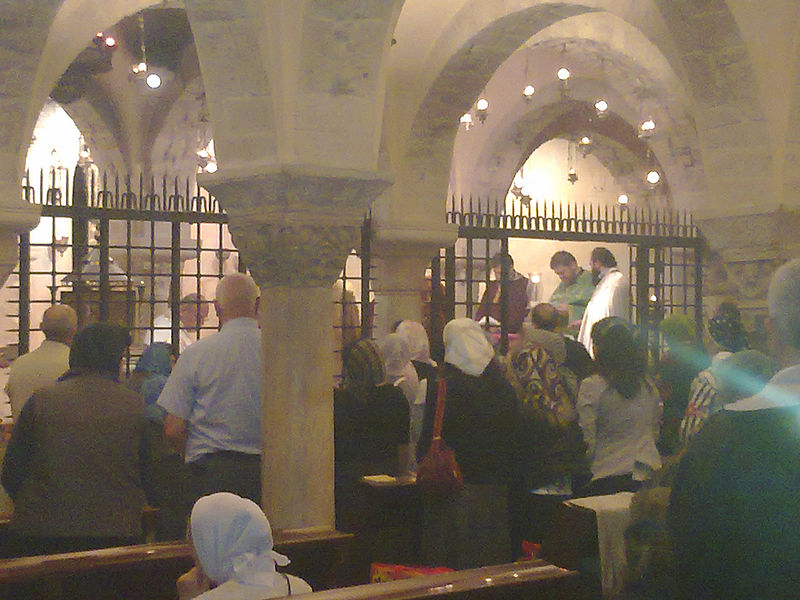
Bari, basilica di San Nicola, cripta. (GNU Free Documentation License)
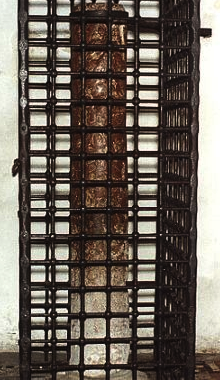
Bari, basilica di San Nicola, cripta, colonna dell’inferriata.
La cripta non è solo lo spazio del sacro, ma è anche lo spazio del racconto e della leggenda, tutto concorre a indurre il devoto al raccoglimento e il viaggiatore all’ascolto, come quando si scorge, in un angolo, un’antica colonna circondata da un’inferriata. Anche su questo oggetto, nel corso dei secoli, si sono tramandate numerose leggende che hanno contribuito ad accrescere la devozione dei baresi e dei pellegrini per San Nicola. Si racconta che, dopo il Concilio di Nicea, Nicola si recò a Roma a rendere omaggio a papa Silvestro. Nella città capitolina, dinanzi alla casa in demolizione di una donna di facili costumi, ammirò una bella colonna e la sospinse nel Tevere da dove miracolosamente giunse sino al porto di Myra, sua città natale. Al suo ritorno da Roma la collocò nella cattedrale della sua città. Si narra che così come miracolosamente la colonna aveva raggiunto la città anatolica, nuovamente la si vide galleggiare nelle acque di Bari, quando le reliquie del Santo giunsero in città. Nessuno tuttavia riusciva a prenderla. La notte precedente la riposizione delle reliquie di San Nicola nella nuova chiesa a lui consacrata, i baresi udirono suonare le campane e accorsero nei pressi della basilica e videro un Santo vescovo che, con due angeli, poneva una colonna dal colore rosa a completamento dell’opera. (Cfr. A. Beatillo, Historia delle vita, miracoli, traslatione, e gloria dell’Illustrissimo confessore di Christo s.Nicolò il Magno, arcivescovo di Mira, patrone, e protettore della città di Bari)
Da allora, quella colonna, che si dice abbia viaggiato da Oriente a Occidente, esattamente come il culto di San Nicola, è diventata oggetto di venerazione per le popolazioni locali, per i pellegrini e in particolare per donne in età da marito.
Molte opere d’arte provenienti dalla Basilica sono oggi conservate nel Museo Nicolaiono che si trova nella città vecchia, poco distante dalla chiesa, in Strada Vanese 3.
